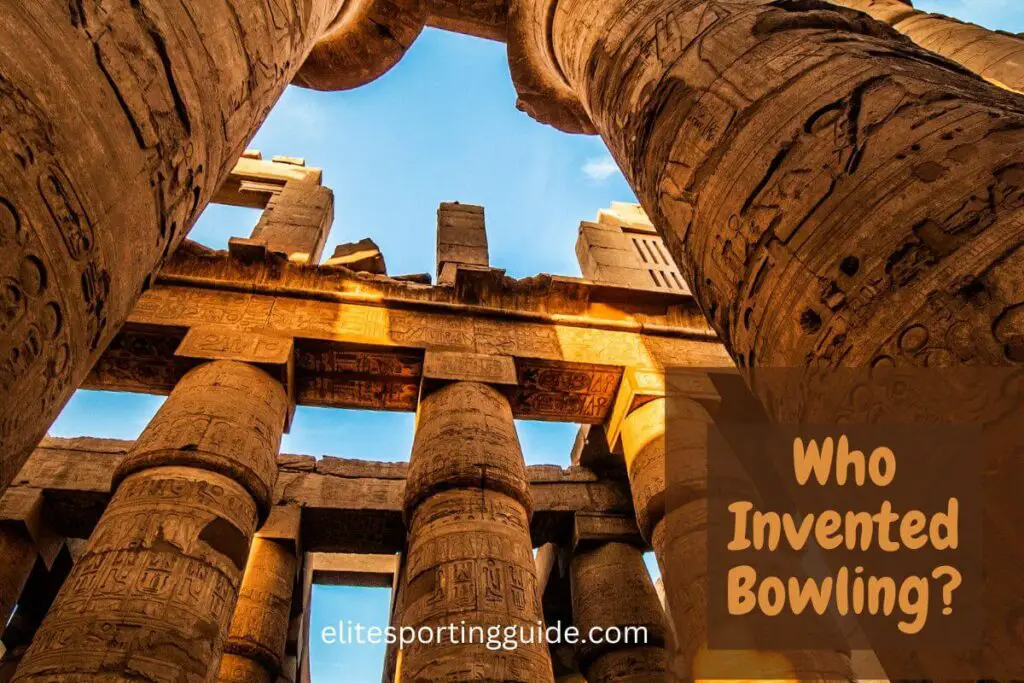The origins of bowling, one of the world’s oldest recreational activities, remain shrouded in mystery.
In this article, you will be exposed to the fascinating history of bowling, exploring its evolution from ancient pastime to modern-day sport and enlightening you on the diverse cultural influences that have shaped this beloved activity throughout the ages.
Who Invented Bowling?
It is believed to have been developed by ancient Egyptians, Greeks, or Romans, and it has evolved over time into the popular sport we know today. The precise origins of bowling are unclear, but the game has been played for thousands of years.
Ancient Egypt
Ancient Egypt, known for its remarkable contributions to civilization, can also be considered a cradle of early bowling practices.
While the exact origins of bowling are uncertain, evidence suggests that the ancient Egyptians engaged in a game resembling modern-day bowling.
Archaeological discoveries have revealed ancient Egyptian artifacts depicting scenes that depict individuals rolling a ball towards a set of pins.
These ancient depictions, found in tombs and temple walls, provide valuable insights into the early forms of bowling in Egyptian society.
Bowling in ancient Egypt was not just a recreational activity; it held symbolic and religious significance as well. It was believed that knocking down the pins represented triumph over evil forces, and the game was often associated with rituals and offerings to appease the gods.
Bowling was considered a part of the Egyptians’ quest for balance and harmony in both the earthly and divine realms.
Through their ingenuity and cultural practices, the ancient Egyptians left a lasting legacy in the realm of sports and games, with bowling being among their noteworthy contributions.
The early development of bowling in ancient Egypt highlights the profound role of leisure activities in the lives of the Egyptians and adds another layer of intrigue to their diverse and vibrant civilization.
Greece and Rome

Both ancient Greece and Rome played a significant role in the development and evolution of early variations of bowling games.
In Greece, a game known as “Kottabos” gained popularity during the 5th and 4th centuries BCE. This game involved flinging wine lees from cups to hit targets, showcasing elements of precision and skill that resonate with modern bowling.
Moving to ancient Rome, a game called “Bocce” emerged as a precursor to modern bowling. Bocce involved throwing or rolling a small ball (called a “jack”) and then attempting to get larger balls as close to the jack as possible.
This early form of bowling was not only a recreational pastime but was also enjoyed by soldiers and nobility alike.
These early variations of bowling games in Greece and Rome not only provided entertainment but also served as social activities that brought communities together.
The influence of these ancient Greek and Roman games can be seen in the development and rules of bowling games that have evolved over the centuries.
Medieval Europe
During the Middle Ages, bowling underwent further evolution and gained widespread popularity throughout Europe.
Initially, the game was known as “Ninepins” and was played predominantly by the upper class and royalty. Ninepins involved setting up nine pins in a diamond shape and using a ball to knock them down.
In Medieval Europe, bowling alleys became common gathering places, attracting people from all walks of life.
Bowling provided a form of entertainment, recreation, and social interaction, fostering community engagement and friendly competition.
Bowling leagues and tournaments emerged, further fueling the game’s popularity and creating a sense of solidarity among players.
Over time, the game of Ninepins faced opposition from authorities who saw it as a form of gambling and a distraction from more serious pursuits.
As a result, various regulations and restrictions were imposed, including changes to the number of pins used. This led to the development of “Tenpins,” which became the dominant form of bowling in Europe by the 17th century.
The evolution and popularity of bowling during the Medieval period laid the foundation for the modern sport we know today.
The social aspects, competitive spirit, and the enjoyment derived from knocking down pins continued to resonate with people throughout the centuries, making bowling a timeless pastime that has endured and thrived across different cultures and continents.
The Emergence of Modern Bowling
The emergence of modern bowling as a sport can be traced back to the 19th century in the United States.
Bowling began to transition from a casual pastime to a more organized and competitive activity during this time.
The introduction of standardized rules, the establishment of bowling clubs and associations, and the development of indoor bowling alleys were key factors in this transformation.
In 1895, the American Bowling Congress (ABC) was formed, marking a significant milestone in the sport’s development. The ABC aimed to establish uniform rules and regulations, as well as organize national competitions.
This provided a platform for bowlers to showcase their skills and compete on a larger scale.
Another crucial advancement was the invention of automatic pin-setting machines in the early 20th century. These machines eliminated the need for manual pin-setting, allowing for more efficient gameplay and increased the pace of the sport.
It also made bowling more accessible and appealing to a wider audience.
Throughout the 20th century, bowling continued to grow in popularity, becoming a cherished recreational activity and a professional sport.
The formation of professional bowling organizations, such as the Professional Bowlers Association (PBA) in 1958, further elevated the status of bowling as a competitive sport and paved the way for professional bowlers to showcase their talent on a global stage.
Today, bowling is enjoyed by millions of people worldwide, with numerous professional tournaments, televised events, and dedicated bowling facilities.
The transformation of bowling from a leisurely activity to a highly organized and competitive sport is a testament to its enduring appeal and the passion it evokes in players and enthusiasts alike.
Post you may like: What type of activity is Bowling?
Cultural Influences on Bowling
Bowling, as it spread across different regions, underwent cultural influences that shaped unique regional traditions and variations of the game. Here are a few notable examples:
1. Candlepin Bowling (North America): Primarily played in the New England region of the United States and parts of Canada, candlepin bowling features tall, thin pins and smaller, cylindrical balls.
The game requires precise aim and skill due to the pins’ slender design, resulting in a distinct style of play and scoring.
2. Lawn Bowling (United Kingdom): Originating in ancient Egypt and later popularized in medieval Europe, lawn bowling found a special place in British culture.
Played on meticulously maintained grass surfaces, lawn bowling involves rolling biased balls towards a smaller target ball called the jack. It retains a sense of tradition and is often associated with a leisurely social activity.
3. Skittle Bowling (Germany): Skittle bowling, known as Kegeln in Germany, is a traditional sport. The game involves aiming at pins arranged in a triangular shape and knocking them down with a ball.
Skittle bowling is often played in beer gardens or specialized bowling alleys known as Kegelbahnen and is deeply intertwined with German social customs and conviviality.
4. Duckpin Bowling (United States and Canada): Popular in the northeastern parts of the United States and eastern Canada, duckpin bowling features smaller, squat pins and a handheld-sized ball. The pins are difficult to knock down, making the game a challenging yet enjoyable experience.
These examples demonstrate how bowling has evolved and diversified, adapting to regional preferences and cultural norms. Each variation adds its own flair, rules, and techniques, highlighting the rich tapestry of bowling traditions across the globe.
Bowling in the 20th Century: Technological Advancements and Organized Competition

The 20th century brought significant advancements to the world of bowling, both in terms of technology and organized competitions. These developments transformed bowling into a highly sophisticated sport enjoyed by millions worldwide.
Technological innovations played a pivotal role in enhancing the bowling experience.
Automatic pin-setting machines, introduced in the early 1900s, eliminated the need for manual pin-setters and improved the efficiency of gameplay.
Additionally, the introduction of synthetic lanes in the 1970s provided a more consistent surface for bowling, reducing maintenance efforts and offering bowlers a more predictable playing environment.
Organized competitions also flourished during the 20th century.
The Professional Bowlers Association (PBA), established in 1958, became the premier organization for professional bowling, organizing tournaments and creating a platform for skilled bowlers to compete at the highest level.
Television coverage of bowling events, such as the PBA Tour, further popularized the sport, allowing fans to witness the excitement and skill of professional bowlers from the comfort of their homes.
The 20th century also saw the inclusion of bowling in major multi-sport events. Bowling made its debut as a demonstration sport in the 1936 Olympic Games held in Berlin.
While it hasn’t become a permanent Olympic event, it has been featured in various regional and international multi-sport competitions, such as the Pan American Games and the Asian Games.
With technological advancements and increased organizational structure, bowling in the 20th century experienced a significant surge in popularity.
The sport became more accessible, competitive, and garnered a dedicated fan base, solidifying its position as a beloved recreational activity and professional sport.
Post you may like: Is Bowling An Olympic Sport?
Bowling in the Present: Global Popularity and Contemporary Innovations
Bowling remains a highly popular sport in the present day, enjoyed by people of all ages and skill levels around the world.
Its global appeal is evident in the multitude of bowling centers and leagues spanning continents, with enthusiastic participation from casual bowlers and competitive athletes alike.
Contemporary innovations have further enhanced the bowling experience. Advanced lane technology, including computerized scoring systems and LED screens displaying player statistics, has made the game more interactive and engaging.
Video projection mapping and light effects have also been incorporated into bowling alleys, creating immersive environments and adding a modern twist to the traditional setting.
In recent years, there has been a surge in alternative bowling formats to attract new audiences.
Cosmic bowling, with its black lights and neon glow, offers a vibrant and lively atmosphere for late-night bowling sessions.
Bowling alleys have also introduced themed events, such as glow-in-the-dark bowling, music-themed nights, and even bowling with augmented reality elements.
The rise of competitive Esports has also impacted bowling. Virtual bowling leagues and video game adaptations have emerged, allowing players to compete digitally and test their skills against opponents from around the globe.
Furthermore, bowling continues to adapt to contemporary societal trends.
Many bowling centers now offer gourmet food options, craft beverages, and social lounges to create a comprehensive entertainment experience beyond the game itself.
Bowling’s present-day popularity is propelled by a combination of global participation, technological advancements, and innovative approaches to attract diverse audiences.
As it evolves with the times, bowling remains a cherished pastime and a sport that continues to captivate enthusiasts worldwide.
Unraveling the Mystery
The true inventor of bowling remains an enigma, as the origins of the game are obscured by the passage of time and the lack of definitive historical records.
Various ancient civilizations, including the Egyptians, Greeks, and Romans, have been credited with early forms of bowling, but attributing the invention to a single individual is challenging.
The earliest evidence of bowling-like games dates back thousands of years, with different cultures having their own versions.
Ancient Egyptian artifacts depict scenes resembling bowling, while Greek and Roman societies had similar games involving rolling balls towards targets.
These early iterations laid the foundation for the development of modern bowling.
It is likely that bowling evolved over time through the collective efforts of multiple cultures, each contributing to its progression and refinement.
The game gradually transformed and spread across different regions, adopting various rules and styles along the way.
While the exact inventor of bowling may remain unknown, the enduring appeal and widespread popularity of the game attest to its timeless nature.
Bowling’s evolution is a testament to the human desire for recreational activities, social interaction, and friendly competition enjoyed by millions today.
Celebrating Bowling’s Legacy
Bowling’s enduring appeal across generations is a testament to its remarkable legacy as a treasured recreational activity.
Spanning centuries, bowling has continued to captivate people of all ages, transcending cultural boundaries and technological advancements.
One of the key factors behind bowling’s longevity is its inherent social nature. Whether played in a casual setting or as part of organized leagues, bowling brings people together from all ages.
The joy of sharing laughter, celebrating strikes, and consoling spares creates lasting memories and strengthens bonds between family members, friends, and even co-workers.
Bowling’s accessibility contributes to its widespread popularity. People of different skill levels can participate, from beginners rolling their first ball to seasoned bowlers honing their techniques.
Bowling alleys provide a welcoming environment where individuals can enjoy the game at their own pace, making it inclusive for people of all abilities and backgrounds.
The adaptability of bowling to changing times has also contributed to its appeal.
From traditional ten-pin bowling to variations like candlepin, duckpin, and more, there is a style of bowling to suit different preferences and regional traditions.
Additionally, the incorporation of modern technologies, such as automated scoring systems and interactive features, keeps the game fresh and engaging for younger generations.
Furthermore, bowling’s evolution into a professional sport, with televised tournaments and skilled athletes competing at the highest level, has garnered a dedicated fan base and inspired aspiring bowlers worldwide.
Bowling’s legacy endures because it combines the elements of competition, fellowship, and fun in a way that transcends generations.
It provides a timeless source of enjoyment, forging connections and creating cherished memories that will continue to be treasured for years to come.



